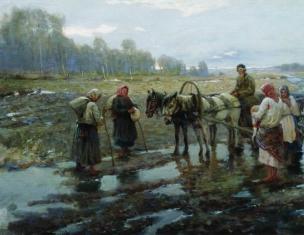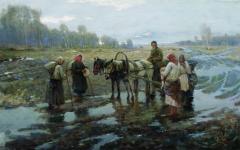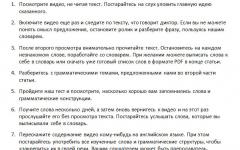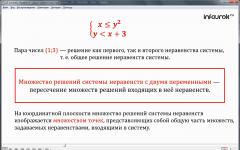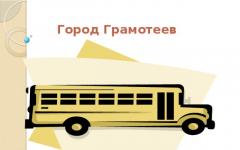Svetlana Golubeva
The manual will assist in the formation syllable structure, in improvement grammatical structure speech and reading skills, expanding vocabulary, development phonemic perception.

1. D/game "Pick a Rhyme".
Target: learn to select pairs of rhyming words; develop phonemic awareness.


Game option:
One of the players spins his disk, the other player selects a picture whose name rhymes. For example: cone-bear, etc.
2. D/game "Make a proposal".
Target: teach children to make sentences of various types using given words; develop verbal creativity, fantasy.


Game option:
Each player promotes his disk, then the players take turns coming up with sentences with the words that matched on disks.
For example:
The girl stroked the little kitten.
The kitten was sitting on the girl's lap.
You can discuss in advance what proposals should be (with prepositions, how many words, etc.)
For a correctly composed sentence, the player receives a chip.
3. D/game "Pick a letter".
Target: exercise children in identifying the first sound in a word. To consolidate children's knowledge of the sounds and letters they have learned.

For each picture we select the letter with which the word begins. Having previously determined what the first sound is heard in the title of the picture.
4. D/game "Make a Word".
Target: reading and composing two-syllable words.


Game options:
One child can form two-syllable words.
A teacher and a child or two children can play. One sets a syllable, the other selects a second syllable to make a word.
Target. Teach children to correctly characterize spatial relationships and select rhyming words.
Progress of the lesson
The teacher draws the children’s attention to sheets of paper and “washers” (chips) lying in front of each of them.
“Have you forgotten the game of hockey? - the teacher is interested. And he clarifies: “The impact and where might the puck end up?”
Listens to the children’s answers, suggests the direction of the puck’s flight, for example: “The puck is flying above the goal, to the left of it.”
The teacher calls a child who wants to report from the hockey field (the child answers from his seat). Then another child comments on the hockey players' training. The exercise is repeated 3-4 times.
The teacher, standing behind the children, observes who moves the puck on a sheet of paper in order to later work with some of the children individually.
“Today I will not treat you to coffee, as we will play the game “Say a word” (“Choose a rhyme”),” the teacher says. – A very famous poetess Elena Blaginina composed cunning poems. Listen to them carefully."
The teacher reads E. Blaginina’s poem “There is still a game...”:
It's snowing outside,
Holiday coming soon...
- New Year.
The needles glow softly,
The pine spirit comes from...
- Christmas trees!
The branches rustle faintly,
The beads are bright...
- They shine.
(“Or maybe they spark? They hiss?”)
And the toys swing -
Flags, stars...
- Firecrackers!
(“Not cuckoos? Not frogs? And, of course, not ears?”)
Threads of colorful tinsel,
Bells...
- Balls!
(“Balls or Gifts?”)
Fragile fish figures,
Birds, skiers...
- Snow Maidens!
Whitebeard and Rednose,
Under the branches of Grandfather...
- Freezing!
January
Lesson 1. Conversation on the topic: “I dreamed...” Didactic game “Choose a rhyme”
Target. Teach children to participate in a collective conversation, helping them construct meaningful statements.
Progress of the lesson
“Today we will again learn to speak correctly,” the teacher begins the lesson. - Let's talk to you about the New Year holiday. All people, adults and children, were waiting for the New Year: gifts, guests, travel, beautiful Christmas trees. Tell us what you dreamed of before the New Year and how you spent the New Year holidays.”
The teacher listens to the child’s story, makes the necessary corrections, and asks clarifying questions. Then she evaluates the answer, noting its logic and expressiveness (unusual comparisons, emotionality).
Calls 2-3 more guys. He tries to listen to the stories of those children who spent the New Year holidays in different ways.
It is also advisable to listen to a child experiencing various kinds of difficulties in mastering native language. But this child must be prepared in advance and rejoice at his successes together with the children.
In order to add variety to the conversation and please the children, you can play the didactic game “Choose a Rhyme” using the following works:
The puppy looked through the window:
- What does... (the cat) enjoy?
- There are all sorts of people walking around here, look!
- Looks evil at the cat... (mouse).
- Maybe it’s enough, mouse, to be angry?
- Chirped... (tit).
Didn't say anything
Sleeping under the bed... (dog).
E. Lavrentyeva “Choose a rhyme”
* * *
My dear children!
I am writing you a letter:
I ask you to wash more often
Your hands and... (face).
My dear children!
I really, really ask you:
Wash cleaner, wash more often -
I'm dirty... (I can't stand it).
Y. Tuvim. “A letter to all children on one very important matter,” trans. from Polish S. Mikhalkov
On the merry ones,
On the greens
Horizon Islands,
According to scientists,
Everyone walks... (on their heads).
Through the mountains
On a scooter
They go there
Bulls... (in tomatoes)!
And one scientist cat
He even drives... (helicopter).
Ya. Bezheva. “On the Horizon Islands”, trans. from Polish B. Zakhoder
Lesson 2. Reading the story by S. Georgiev “I saved Santa Claus”
Target. Introduce children to new things a work of art, help to understand why this is a story and not a fairy tale.
Preliminary work. Having replenished the corner of the book with new collections of works, the teacher invites the children to find fairy tales, stories, and poems. You can divide the children into three groups. The first group will select fairy tales, the second - short stories, the third - poems. Groups of children will work in turns, and each subsequent group can look at the books of the previous group(s) to determine if they have the works they want to select.
Progress of the lesson
The teacher evaluates the children's work (their diligence and conscientiousness). Then he looks through the first stack of books. It makes more sense to start with collections of poetry. Children often classify fairy tales by A. Pushkin and K. Chukovsky as poetry. The teacher finds out whether this is legal and to which group of works this or that book belongs.
“This is a fairy tale in verse,” explains the teacher.
The next group of children proves that the books they have chosen are fairy tales (stories).
Having assessed the children’s knowledge and intelligence, the teacher reads to them S. Georgiev’s story “I Saved Santa Claus” (see Appendix). Then he asks whether they liked the new work and whether it is a fairy tale or a story.
Academy of educational games. For children from one to 7 years old Novikovskaya Olga Andreevna
Find a rhyme
Find a rhyme
Ask your child to help write short poems. Say the words of the couplet, stopping for last word. The last rhyming word is selected together with the baby (he needs to be offered 2 words to choose from).
Where are you in a hurry, Marina?
To the forest, where the ripe...
The rhyme offers a choice of berry names: “raspberry” and “blueberry”. If the child finds it difficult to make a choice, then the adult pronounces the couplet first with a non-rhyming word, and then with a rhyming word, inviting the child to choose the one that sounds better. When the rhyming word is selected, the child repeats the rhyme on his own: “Where are you rushing, Marina? To the forest, where there are ripe raspberries."
Examples of couplets:
We bought the cat
For the holiday...(Bow, boots)
I sewed a shirt for a bear.
I'll sew him...(Jacket, pants)
We'll wash it now
I need soap, I need...(Powder, basin)
My sister's
Long…(Braids, ponytails)
On a swamp hummock
Grew up...(berries, mushrooms)
We visited the forest
We saw there...(Bear, fox)
Sat by the window
Gray...(Kitty, dog)
I've got a heavy load
I'm taking it home...(Apples, watermelon)
Bye, bye, don't cry,
I'll buy you...(Pie, roll)
Gave it to a bear
For your birthday...(Car, books)
Oksanka is shedding tears:
She's broken...(Skis, sleds)
The dog brought a bouquet to the goat -
It will be satisfying for her...(Dinner, lunch)
A fly bit the kitty,
And the kitty hurts...(Paw, ear)
The game activates attention, develops speech hearing, and teaches the child to select rhymes.
This text is an introductory fragment. From the book Encyclopedia of Methods early development author Rapoport AnnaPick a Cap Slowly unscrew the caps and caps from bottles and jars of different sizes. Show your child how the caps are selected and screwed on. Then mix the caps and arrange the bottles and jars on the table. Invite your child to independently find the lids for each
From the book Academy of Educational Games. For children from one to 7 years old author Novikovskaya Olga AndreevnaSelect according to shape Prepare three balls, three cubes, three bricks, three prisms of the same color. Place all these items randomly on the table. Show your child how to choose only cubes from among the objects. At the same time say: “This is a cube. And here's another cube. And another cube like that.”
From the author's bookChoose a lid Prepare three to four small boxes different shapes and sizes with removable lids, for example, square, round, rectangular, triangular, oval, heart-shaped... Place the boxes on the table and remove the lids from them. Offer your child again
Target. Teach children to correctly characterize spatial relationships and select rhyming words.
Progress of the lesson
The teacher draws the children’s attention to sheets of paper and “washers” (chips) lying in front of each of them.
“Have you forgotten the game of hockey? - the teacher is interested. And he clarifies: “The impact and where might the puck end up?”
Listens to the children’s answers, suggests the direction of the puck’s flight, for example: “The puck is flying above the goal, to the left of it.”
The teacher calls a child who wants to report from the hockey field (the child answers from his seat). Then another child comments on the hockey players' training. The exercise is repeated 3-4 times.
The teacher, standing behind the children, observes who moves the puck on a sheet of paper in order to later work with some of the children individually.
“Today I will not treat you to coffee, as we will play the game “Say a word” (“Choose a rhyme”),” the teacher says. – A very famous poetess Elena Blaginina composed cunning poems. Listen to them carefully."
The teacher reads E. Blaginina’s poem “There is still a game...”:
It's snowing outside,
Holiday coming soon...
- New Year.
The needles glow softly,
The pine spirit comes from...
- Christmas trees!
The branches rustle faintly,
The beads are bright...
- They shine.
(“Or maybe they spark? They hiss?”)
And the toys swing -
Flags, stars...
- Firecrackers!
(“Not cuckoos? Not frogs? And, of course, not ears?”)
Threads of colorful tinsel,
Bells...
- Balls!
(“Balls or Gifts?”)
Fragile fish figures,
Birds, skiers...
- Snow Maidens!
Whitebeard and Rednose,
Under the branches of Grandfather...
- Freezing!
January
Lesson 1. Conversation on the topic: “I dreamed...” Didactic game “Choose a rhyme”
Target. Teach children to participate in a collective conversation, helping them construct meaningful statements.
Progress of the lesson
“Today we will again learn to speak correctly,” the teacher begins the lesson. - Let's talk to you about the New Year holiday. All people, adults and children, were waiting for the New Year: gifts, guests, travel, beautiful Christmas trees. Tell us what you dreamed of before the New Year and how you spent the New Year holidays.”
The teacher listens to the child’s story, makes the necessary corrections, and asks clarifying questions. Then she evaluates the answer, noting its logic and expressiveness (unusual comparisons, emotionality).
Calls 2-3 more guys.
He tries to listen to the stories of those children who spent the New Year holidays in different ways.It is also advisable to listen to a child experiencing various kinds of difficulties in mastering his native language. But this child must be prepared in advance and rejoice at his successes together with the children.
In order to add variety to the conversation and please the children, you can play the didactic game “Choose a Rhyme” using the following works:
The puppy looked through the window:
- What does... (the cat) enjoy?
- There are all sorts of people walking around here, look!
- Looks evil at the cat... (mouse).
- Maybe it’s enough, mouse, to be angry?
- Chirped... (tit).
Didn't say anything
Sleeping under the bed... (dog).
E. Lavrentyeva “Choose a rhyme”
* * *
My dear children!
I am writing you a letter:
I ask you to wash more often
Your hands and... (face).
My dear children!
I really, really ask you:
Wash cleaner, wash more often -
I'm dirty... (I can't stand it).
Y. Tuvim. “A letter to all children on one very important matter,” trans. from Polish S. Mikhalkov
On the merry ones,
On the greens
Horizon Islands,
According to scientists,
Everyone walks... (on their heads).
Through the mountains
On a scooter
They go there
Bulls... (in tomatoes)!
And one scientist cat
He even drives... (helicopter).
Ya. Bezheva. “On the Horizon Islands”, trans. from Polish B. Zakhoder
Lesson 2. Reading the story by S. Georgiev “I saved Santa Claus”
Target. Introduce children to a new work of fiction, help them understand why this is a story and not a fairy tale.
Preliminary work. Having replenished the corner of the book with new collections of works, the teacher invites the children to find fairy tales, stories, and poems. You can divide the children into three groups. The first group will select fairy tales, the second - short stories, the third - poems. Groups of children will work in turns, and each subsequent group can look at the books of the previous group(s) to determine if they have the works they want to select.
Progress of the lesson
The teacher evaluates the children's work (their diligence and conscientiousness). Then he looks through the first stack of books. It makes more sense to start with collections of poetry. Children often classify fairy tales by A. Pushkin and K. Chukovsky as poetry. The teacher finds out whether this is legal and to which group of works this or that book belongs.
“This is a fairy tale in verse,” explains the teacher.
The next group of children proves that the books they have chosen are fairy tales (stories).
Having assessed the children’s knowledge and intelligence, the teacher reads to them S. Georgiev’s story “I Saved Santa Claus” (see Appendix). Then he asks whether they liked the new work and whether it is a fairy tale or a story.


